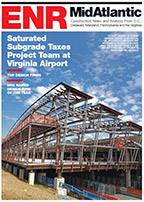Debate over the Metropolitan Washington Airports Authority’s decision to construct an underground station at Dulles Airport as part of its Metrorail extension project intensified this week, with local political leaders criticizing the choice as “irresponsible” and the agency defending the move as being in the best long-term interests of passengers and the community.
The controversy stems from the MWAA’s April 6 approval of a plan to locate the subsurface station 500 ft from the main Dulles Terminal.
Although the $600-million station and associated tunnel were part of the original 2005 design for the $3.5-billion second phase of the 23-mile light rail extension project, concerns about rising construction costs led the agency to explore other options, including an above-ground station sited approximately 1,000 ft further away and linked to an existing pedestrian access tunnel.
But a revised design by MWAA’s Phase 2 preliminary engineer, Dulles Rail Consultants, a team led by Parsons Brinckerhoff and AECOM, indicated that the underground station’s cost could be reduced by as much as $330 million without compromising amenities or service. The changes include a simplified station design, locating the tunnel and station at a shallower depth to reduce the amount of excavation required, reducing the tunnel’s length by shifting the outbound portal south, and use of cut and cover construction rather than mining methods.
MWAA would also utilize an existing chiller plant for air conditioning rather than build a new facility, and locate a new electrical substation above ground.
In an April 17 Washington Post opinion column, Mame Reiley, chair of the Dulles Corridor Committee for MWAA’s Board of Directors, called the redesigned terminal station “vastly more passenger-friendly than the alternatives, a key driving factor in airport use and consumer satisfaction,” and that ongoing efforts to cut project costs will further reduce the cost differential.
Such promises did little to satisfy Rep. Frank Wolf (R ), who represents much of the area that will be directly served by the extension, and is a long-time supporter of a mass transit alternative for the Dulles Corridor. Absent a large federal subsidy such as the $900 million FTA New Starts grant that’s supporting the extension’s initial $2.7 billion, 11.6-mile section, Phase 2 is being funded largely by local jurisdictions and revenue from the MWAA-owned Dulles Toll Road.
As such, Wolf considers the underground station “a bad decision” that increases the financial burden on local residents and businesses, particularly since the jurisdictions involved had previously expressed their opposition to that option.
“It is clear that the MWAA Board ignored the consequences for individuals and businesses in northern Virginia,” Wolf said at a press conference where he was joined by local elected officials as well as representatives from the Associated Builders and Contractors, AAA Mid-Atlantic, and the Virginia Chamber of Commerce.
Wolf, who has called for a U.S. Dept. of Transportation audit of the Dulles Metrorail project, plus a U.S Government Accountability Office review of MWAA’s operations, also criticized the agency’s decision to require a Project Labor Agreement or Phase 2 construction contracts.
The MWAA Board resolution adopting a PLA similar to the one used for the extension’s first phase cites the agreement’s role in ensuring price and schedule certainty, safety, and project quality, as well as its potential role in helping lure additional federal aid to the project.
In a letter to MWAA Board Chairman Charles Snelling, however, Wolf shared his “understanding” that several large, merit-based construction firms would not bid on Phase 2 if they are required to agree to a PLA.
“Discouraging their bids will make Phase 2 subject to more costly union hiring, work and pension regulations,” Wolf wrote.
In hopes of defusing the controversy, Snelling has offered to meet with the MWAA’s critics to discuss the rationale behind the agency’s decision and its strategy for controlling the costs of Phase 2. Under the agency’s current schedule, the project will be put out for bid later this year with completion targeted for 2017.
Phase 1 of the extension, which MWAA says is 30% complete, on budget and on schedule, is slated to begin operation in 2013.
Virginia Governor Robert McDonnell (R) has since joined the chorus of opposition.
In a letter to MWAA Board Chairman Charles Snelling, McDonnell said that the station and tunnel alignment, to be located approximately 500 feet from the main terminal, �has, by all accounts, been shown to be the much more expensive alignment through the airport, costing hundreds of millions more than the aerial alignment with relatively minimal positive logistical or aesthetic benefit.�
McDonnell�s letter echoed their sentiments about the tunnel decision, sharing their surprise and disappointment, but also the hope �that upon further reflection, the board would come to the more fiscally sound decision to pursue the aerial alignment.�



Post a comment to this article
Report Abusive Comment